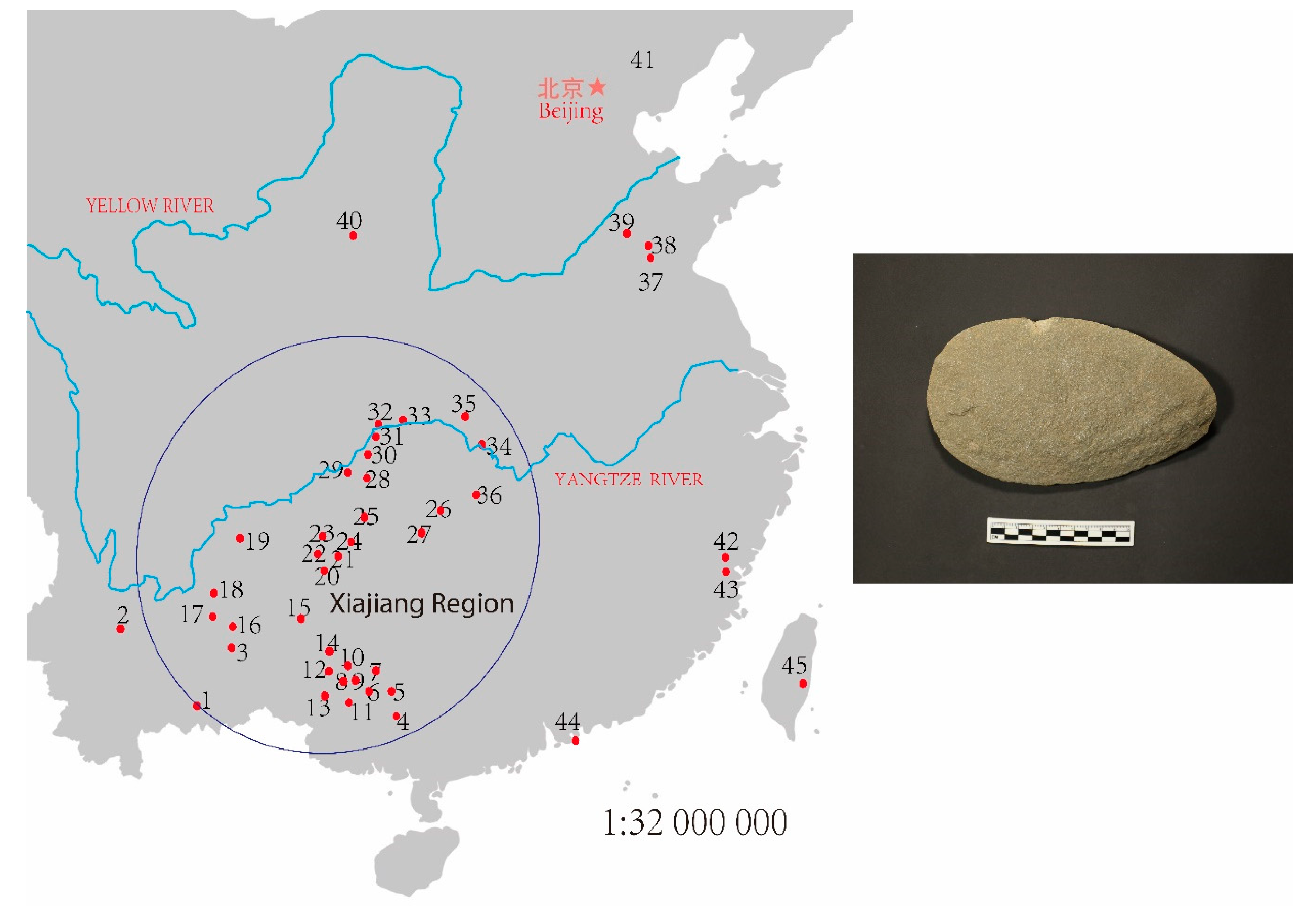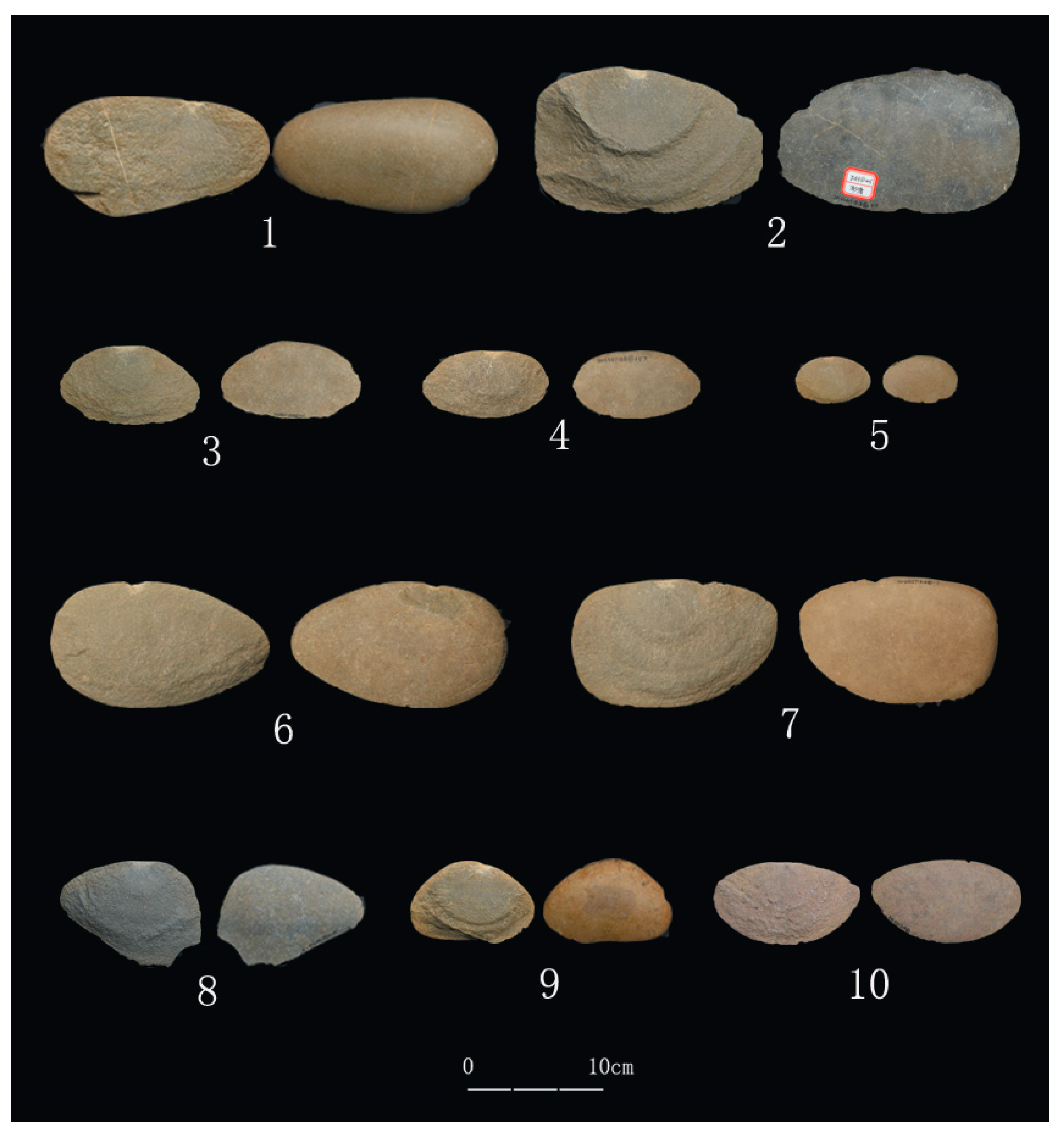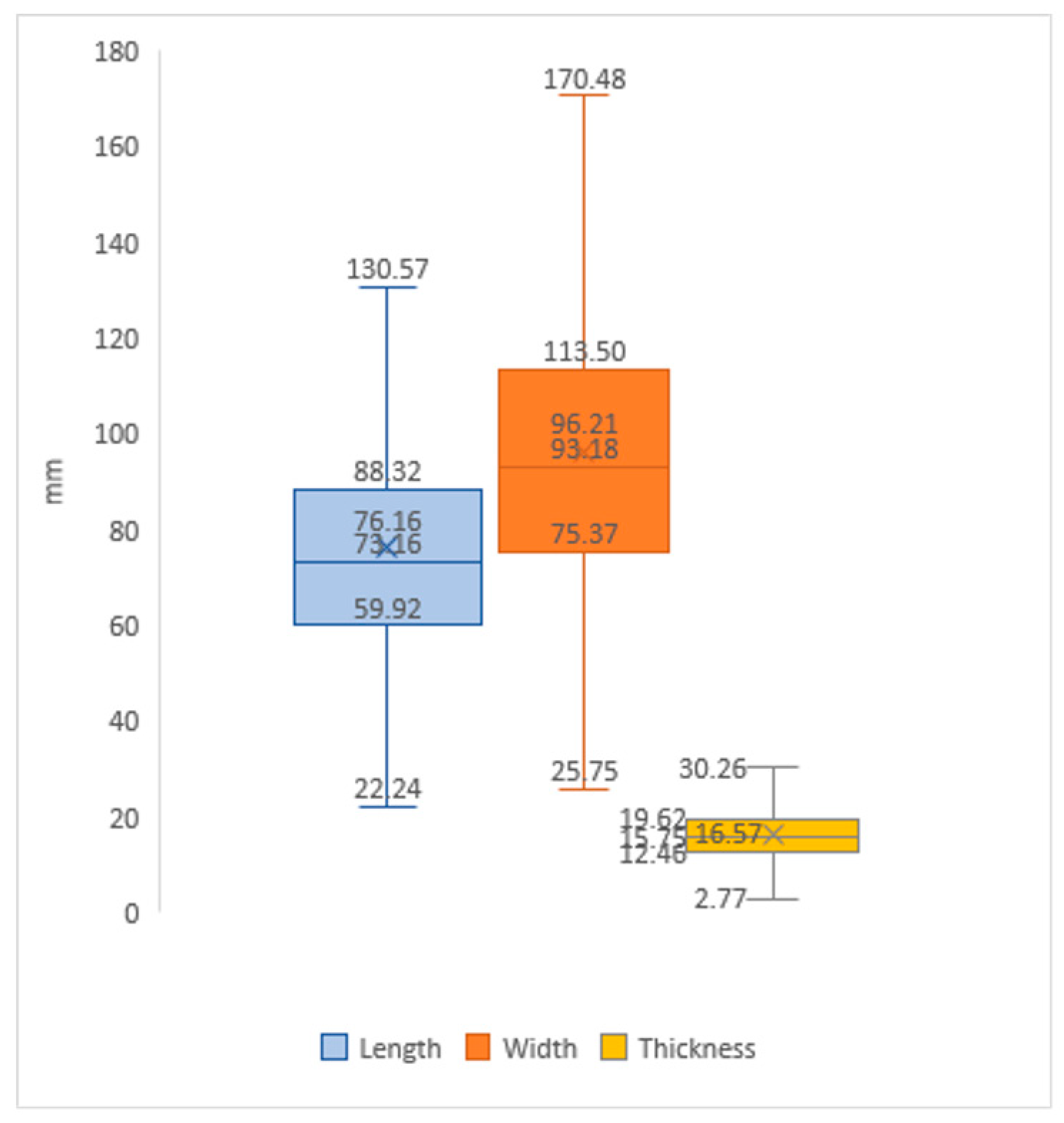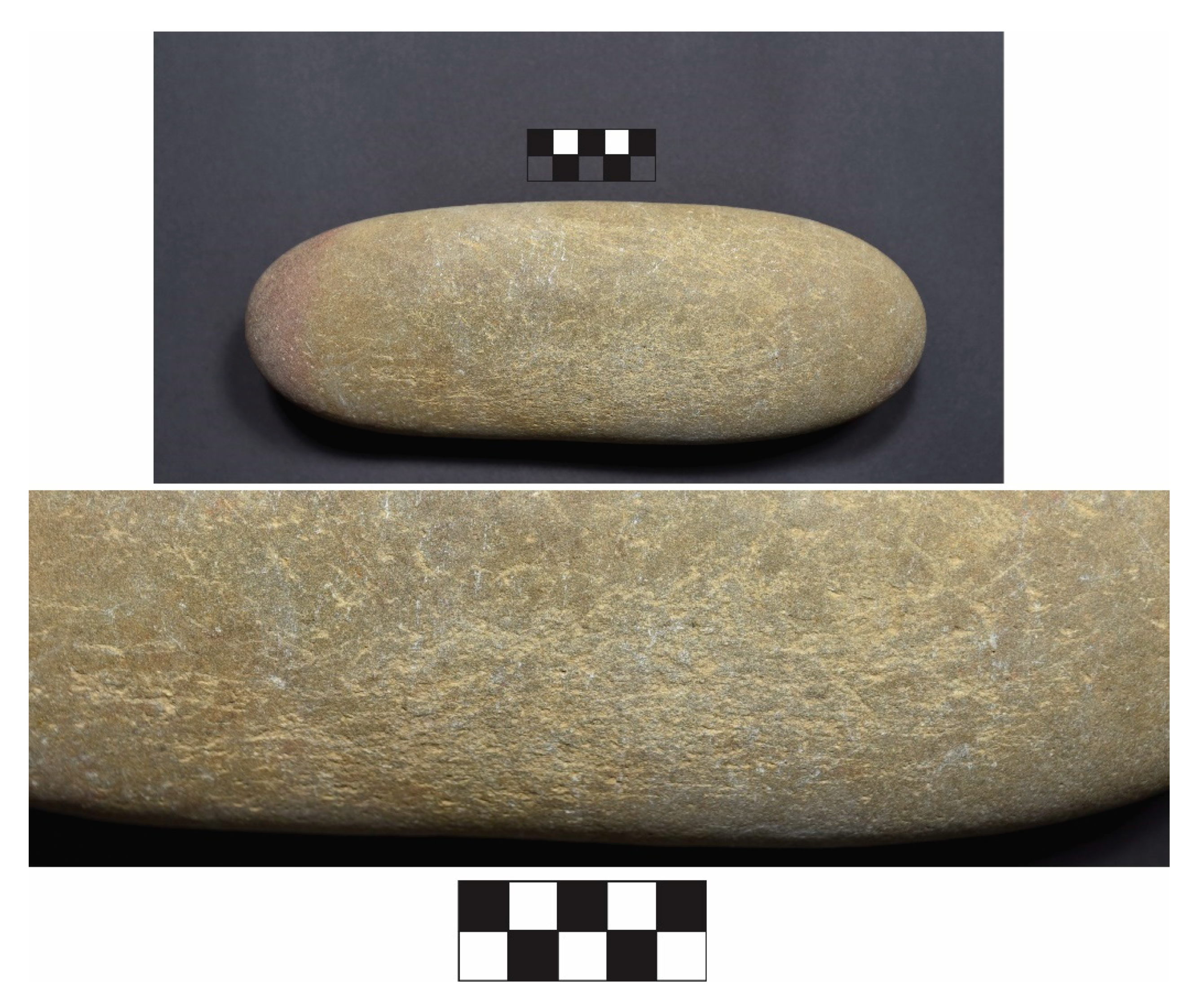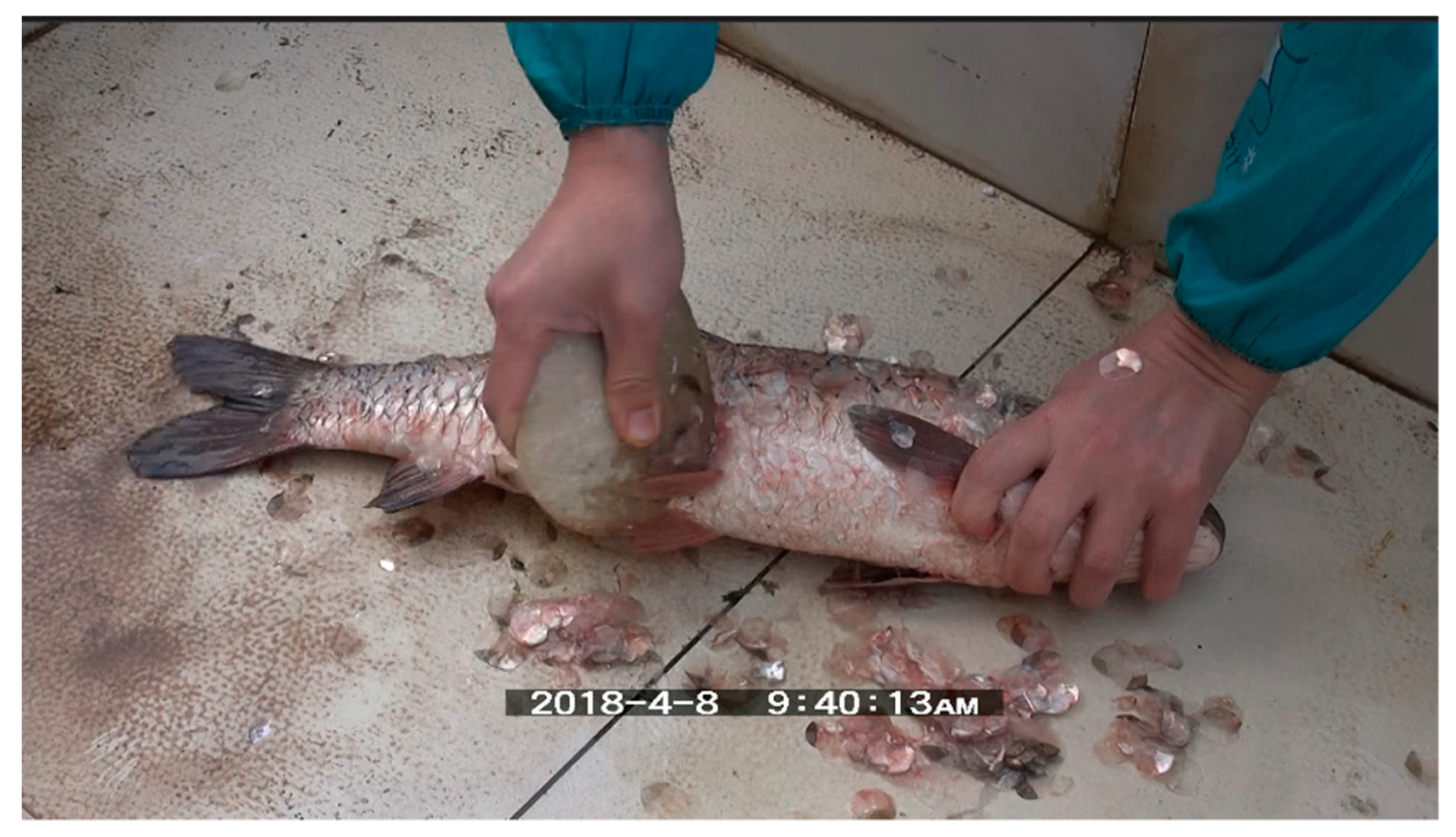1. Introduction
About ten thousand years ago, the arrival of the Holocene was marked by a stable and mild climate after the last ice age terminated. Several dramatic changes in behaviors of prehistoric hunter-gatherers happened during the Paleolithic–Neolithic transition (PNT), such as the appearance of food production, complex social systems, complicated human behaviors, ideology and sedentism [
1]. Meanwhile, in a general trajectory, the human adaptation based on hunting and gathering was replaced by reliance on food production, a process termed the origin of agriculture, also described by V. Gordon Childe as the “Neolithic Revolution” [
2].The global impact of the agricultural revolution on humankind has given rise to “hot” topics including population growth, environmental degradation, the appearance of sedentism, social complexity, and other changes to adaptation strategies. Although the process was prolonged for several thousand years and there are various cultural responses aside from food production, the origin of agriculture has been a major research focus for decades [
1,
3,
4,
5], in other words, agriculture, as an important adaptation during the PNT have been explored much, especially in West Asia, which addresses the influence of environment and population growth [
6,
7,
8]. However, in East Asia, further research is not only needed on the origin of agriculture, but also research relating to nonagricultural adaptations, which have received much less attention.
At present, evidence is fairly clear on the origin of agriculture in China, which includes two centers: North China (the east edge of the Loess Plateau) and South China (the plains of the middle and lower reaches of the Yangtze River). Yet the PNT of noncentral (noncenter regions: except the Loess Plateau and the plain of middle and lower reaches of the Yangtze River, the rest of the places around China are noncenter regions, such as Northeast China, South of the Five Ridges, Qinghai–Tibet Plateau, the mountain areas of the Yangtze reaches (Xijiang region) and so on) regions is still unclear. Since we have studied the question of the PNT for many years, in this paper we investigate the archaeological records in the Xiajiang area (Xiajiang area: the mountain and gorge area along the Yangtze River, including several important terrains, the Three Gorges, mountain area in Southwest China, the edge of Yunnan–Guizhou Plateau) and its adjacent regions, especially first-hand unearthed lithics from the Guanzhou site in Hubei Province. A special pattern of cultural adaptation can be recognized, which is characterized by a unique lithic technology: the “ridged hammer bipolar flaking” (RHBF) technique (see below), a representative technique in the Xiajiang area. Until now, very little research has focused on the question of the PNT process in this region, and only a few studies have been involved (e.g., [
9,
10]). Therefore, the present paper based on an analysis of lithic assemblages in this region can fill in gaps in the question to a certain extent and enrich our overall understanding the diversity about the PNT.
In general, the topography of China consists of three parts: the Tibetan Plateau, the floodplains and hills in the east, and the middle zone between these two parts. The region we discuss, the western part of middle Yangtze valley, is located in the eastern margin of the middle zone where rivers flow into floodplains. The power of rivers to carry sediment rapidly recedes with decreased flow rates, which leads to two consequences that could have impacted lives of prehistoric hunter-gatherers. First, the deposition of river boulders near the reach where a river enters floodplain. This zone can provide abundant raw material, for stone tool manufacturing, of adequate size. In contrast, in the lower reach, it is difficult to find lithic raw material of equivalent size. The other impact is the formation of wetlands in the floodplain, including lakes and seasonal wetlands. Effectively exploiting these special ecological zones would require more complicated technologies: for example, boat and paddle. Therefore, along a river there is an optimal zone for prehistoric hunter-gatherers, where they may find rich lithic raw materials, diverse food resources and a landscape suited for relatively easier mobility. The region discussed above is the transitional zone between the plateaus and hilly floodplains. Notably, the lithic source outcrops are located in more eastern areas, since the sea level in the Terminal Pleistocene did not reach the present level, and lakes along the middle Yangtze valley had not taken their current shape until about 6000 BP.
According to the latest archaeological evidence, the earliest sites with Neolithic features such as domestication, pottery, and sedentism are all located in the hilly flanks of the middle Yangtze valley. Carbonized rice remains suggesting domestication at the site of Xianrendong and Diaotonghuan in Wannian County of Jiangxi Province [
11,
12,
13,
14] and Yuchanyan in Dao County of Hunan Province, correspondingly [
15,
16]. The Yangtze valley in the subtropical zone is a marginal habitat for the growth of wild rice. Up to the Neolithic, there is a continuous sequence from the Shangshan Culture [
17], the Kuahuqiao Culture [
18,
19,
20] to the Hemudu Culture [
21] in the lower Yangtze valley; a sequence similar to that from the Pengtoushan Culture [
22,
23] and the Chenbeixi Culture [
24,
25], the Lower Zaoshi Culture [
26] to the Daxi Culture [
27] in the middle Yangtze valley. It is noted that the PNT can be traced back to about 20,000 years ago, when pottery, polished stone tools and intensive utilization of wild rice appeared in several sites, and this process can be extended to around 8000 BP. This shows the process from the origin of agriculture to the formation of full-developed Neolithic societies is gradual. After the PNT, the Neolithic sites diffused from hilly flanks to floodplains. This tendency is attested by the site distribution from the Pengtoushan Culture to the Daxi Culture. At the same time, agriculture diffuses westward to mountainous zones, including the Sichuan Basin, in which the pottery assemblage of the Daxi Culture has been found. Agriculture in the other parts, confined by natural conditions, was adopted much later. For example, rice farming in Guizhou appeared in the second millennium BC.
The above is the overall situation that we have known up to this time, but the PNT is not clear for the marginal regions of agricultural origin. This transition, which happened worldwide, not only relates to environmental changes at the end of Pleistocene, but also more commonly implies the change in human adaptation—that is, origins of agriculture in various regions of the world. This change brought challenges and opportunities for the hunter-gatherers of noncentral regions in at least three aspects: (1) formation of a new niche with climate amelioration; (2) agriculture or food production as a new technology of cultural adaptation; (3) released constraints from ecological conditions and the inertia of the foraging lifeway inherited from their ancestors. It is generally assumed that hunter-gatherers in the marginal region were not influenced by the changes of the PNT including those from environmental and cultural backgrounds, but continuously kept foraging—their existing lifeways—and thus were forced to accept agriculture later during processes of immigration or other stressors. This assumption has been partially rejected by the results of recently analyzed archaeological records. In fact, foragers could have changed as early as in the central region for agricultural origins, but the form of change could have been different.
2. Background of the RHBF Technique
The ridged hammer bipolar flaking (RHBF) technique has been recognized in the eastern region of the upper reaches of the Yangtze River since the discovery and excavation of a series of sites from the Upper Paleolithic to the early Neolithic in recent years. These new archaeological records provide a precious opportunity to learn about the cultural diversity of this region.
The research relating to the RHBF technique began in the 1970s in China. At that time, RHBF flakes were first found at a prehistoric cave site in Guizhou Province [
28]. Cao [
28] did a preliminary study on these lithic artifacts, and then he named this technique after creating simple experiments. In the report, he described the process in detail: a flat and round boulder used for raw material was brought into contact with the anvil held at a slant, the experimenter firmly held the boulder with one hand and also grasped a hammer in other hand, and then smashed one end of the boulder with the sharp edge of the hammer. Generally, by hitting four or five times, a flake would fall off the boulder. Furthermore, in the following decades, the RHBF technique was reported in many other provinces (
Figure 1).
Although the number of sites found in China is not small (
Figure 1), due to insufficient understanding of RHBF technology and dating problems in previous studies, a systematic study on this lithic technology has not been conducted. Firstly, the definition is still not clear; the early definition was made based on flakes discovered in the cave site and the experiments we mentioned above. However, some following studies reported this type of technique or flakes as the Yangtze technique [
9] or zero-platform flakes [
29]. Secondly, although there are some experiments for the RHBF technique in previous studies, they almost all emphasize the special characteristics of the RHBF technique or other artifacts unearthed along with RHBF flakes [
10]. However, the technical process and function of RHBF technology, particularly, the meaning of cultural adaptation, have not been deeply explored. Thirdly, chronology of the RHBF technique is still a puzzle. On the one hand, some typical sites located in the wilderness area of South China are difficult to get reliable absolute date, since it is impossible to correlate lithic findings to stratigraphy. On the other hand, some sites with RHBF flakes are rescue excavations, thus the dating obtained in Southwest China is speculative and unreliable.
The RHBF technique is long-standing in prehistory. The earliest existence of this technique could date back to the early Paleolithic, at a cave site called Wanshouyan in Fujian Province, Southeast China [
30]. Additionally, sites in southwest China supposedly have evidence that the RHBF technique lasted until the Shang (c. 1570–1045 BC) and Zhou (c. 1045–256 BC) dynasties [
31]. Archaeological sites associated with the RHBF technique are also widely distributed—Southeastern, Northern, and Southwestern China (
Figure 1). However, we argue that this specific technique is mainly distributed in Southwest China, especially in the region from the Xiajiang region to the Yunnan–Guizhou Plateau (part of which extends into the territory of Guangxi) (
Figure 1). The present paper argues that most sites in other regions of China cannot be classified into RHBF technique sites for three reasons:
- (1)
Some artifacts lack the important features of RHBF flakes, e.g., greater width than length, and a linearly notched striking point. For example, although the site in Southeast China, Wanshouyan [
30] consists of some RHBF flakes, most of them are only in a similar shape of RHBF flakes and lack the diagnostic features of this technique.
- (2)
The sample size of RHBF artifacts is small, including only a few flakes discovered from sites of North China.
- (3)
Sporadic discoveries in Southeast and North China have not reported such technique in detail, which makes it difficult to figure out whether they are truly representative of the RHBF technique. Compared with sites in North and Southeast China, sites in the southwest that report RHBF techniques are numerous and mostly cluster in the Xiajiang region. Some of them are also much more clearly described in reports, which provides more compelling contextual evidence to prove the primary existence of RHBF techniques in Southwest China.
3. Materials and Methods
In this study, the Guanzhou site (
Figure 2) was examined based on the observations of lithics and archaeological experiments conducted in 2018. The Guanzhou site, a typical RHBF site, was excavated by the Hubei Provincial Institute of Cultural Relics and Archaeology in 2016. The site is now located on an eyot or small island in the Yangtze River (
Figure 2), which was once connected to the shore about the time before the Ming and Qing dynasties (Ming dynasty tombs were also found on the island, but no later tombs were found). This landform was then cut off from the right bank of the river by a flood and became an eyot. The 2016 excavation unearthed more than 8000 pieces of lithic, of which more than 2000 pieces were RHBF flakes. Among the most exciting and uncommon artifacts were hammers, anvils, and lithic cores—from the RHBF technique—were also discovered, which have provided us with valuable materials for reconstructing this unique lithic technology. Carbon-14 dating indicates this site could date back to around 8500 years ago [
32], the early Neolithic. Similarly, sites with rich RHBF flakes are also known as the Cibingzhou site (the report of this site has not published yet, however, we have visited this site during summer, 2019 and observed the unearthed artifacts) and Maomaodong site in Guizhou [
33,
34], as well as the Tangzigou site in Yunnan [
35]. During the PNT, the popularity of RHBF technology seems to reach its peak, and was widely distributed in China, especially in the Xiajiang region [
36]. In 2019, we inspected the excavated materials at relevant sites in Guizhou, Yunnan, Guangxi, Hunan and other provinces, and confirmed the existence of RHBF techniques in these areas.
The Paleolithic–Neolithic transition occurred worldwide, at least in Eurasia, but different regions do not share the common pattern as can be seen in representative local materials. The eastern region of the upper reaches of the Yangtze River in this study are represented by RHBF technology. In other words, the rise and fall of RHBF technology can better reflect the process of the PNT period in this area, and not only can this show changes in livelihoods, to some extent it, can also show changes in social organization. The method adopted in this article was used to combine the sample analysis and archaeological experiments with ethnoarchaeology to reconstruct the RHBF technology and the function of RHBF flakes, and on this basis, to further understand their meaning in terms of division of labor. Furthermore, we will also draw on the evidence of ethnoarchaeology to support our reasoning.
In the past ten years, we have carried out a series of experimental archaeological studies of stone tools [
36,
37,
38], which helped us to analyze lithic production and form a set of effective methodologies. Our study can be divided into four levels as follows (
Figure 3).
Firstly, observations of the characteristics of the archaeological artifacts, including the classification and description of artifacts, the observation of the use-wear, the analysis of the technology process, and the preliminary assumption of the artifact’s function. Secondly, experimental archaeology and looking for other reference information to support our assumption, such as ethnographic reportage. Thirdly, comparison of artifacts from different sites by considering the local ecology to further verify our judgment. Finally, further explore the meaning of cultural adaptation behind the artifacts or technique. This methodology has been used to analyze the relationship between the prehistoric stone industry in western Liaoning and primitive agriculture; since stone tools are usually the most complete archaeological materials, the analysis of lithics can provide an important reference to understand cultural as well as evolutionary significance in different periods. Therefore, the following section will use this methodology to explore the significance of RHBF technology during the PNT. In this study, the reasoning and analysis will be developed in the following steps:
- (1)
The observation and data recording of lithic artifacts (c. 8000 pieces) from the Guanzhou site, including length, width, height, weight, types of use-wear, position and level, breakage and so on.
- (2)
Replication experiments conducted on the bank of the Yangtze River adjacent to the Guanzhou site. Seven experimenters participate: 2 young male students, 2 young female students, 2 experienced males who have conducted lithic experiments for several years, and 1 less experienced male.
- (3)
Comparative experiments with other lithic techniques, such as throwing, anvil and hammer techniques.
- (4)
A functional experiment aimed to examine the usage of RHBF flakes.
Among the four steps, two key issues need to be addressed. On the one hand, the experimental location is important. Before the flood separated the Guanzhou site from the bank, the experiment location was connected to the site at about 250 m. The close distance between the experimental location and the site means that they share a similar ecological environment, both locales are covered with gravel, and the raw materials are the same as those found in the site so that equivalent ecology and raw material as the Guanzhou site could be easily accessible. On the other hand, comparative experimentation is significant because it is a way to figure out if other lithic techniques can produce the same flakes—although the RHBF technique is regarded as a throwing or anvil technique in previous studies. Since the comparative experiment is not closely related to topic of this study, the result of the comparative experiment will be not shown in the following section.
5. Discussion
5.1. Aquatic Adaptation in East Asia and the RHBF Technique
Although aquatic resources are abundant and relatively accessible, most models of human evolution have all but ignored the role of aquatic or maritime adaptations during the earlier stage of human history [
39]. Besides farming, the use of aquatic resources is also an important adaptation during the PNT, especially in East Asia. By research on the organic residue of Neolithic pottery from Sakhalin Island in the Russian Far East, Gibbs [
40] state that early pottery on Sakhalin was used for the processing of aquatic species, and that its adoption formed part of a wider Neolithic transition involving the reorientation of local lifeways towards the exploitation of marine resources, and other evidence in Russian far east also supports the aquatic use in hunter-gatherer groups [
39]. In Japan and Korean, there is also evidence showing that people in the upper Paleolithic and PNT have access to the aquatic resources [
41,
42,
43]. In China, sites in the PNT indicate there is a potential adaptation strategy relating to aquatic resources, and based on what we mentioned above, the RHBF technique has a potential in aquatic utilization.
The RHBF technique is mainly distributed in the Xiajiang region, where a mountain and gorge area are located in the middle reaches of the Yangtze River. Unlike the plains area of the Yangtze River, the Xiajiang region is not a center for agricultural origins. However, the rise of the RHBF technique may indicate there is an alternative pathway in the cultural evolution during the PNT. Cibingzhou, another site found recently in Guizhou Province, could also support our hypothesis of an alternative strategy in the PNT. Interestingly, the Cibingzhou site shares many similarities with the Guanzhou site. First, the artifacts found were from the same period, the PNT. Secondly, the Cibingzhou site is also located on an eyot that was originally connected to the shore. Additionally, the river was diverted recently, and erosion cut off the eyot. Finally, and most importantly, a large number of RHBF artifacts have been unearthed in the Cibingzhou site. Thus, judging from current records, sites with many RHBF flakes are mostly found near rivers or other water resources, and appeared around 8000 years ago. Because there is a possibility that the RHBF technique is suitable to process fish, based on the functional experiment, it is reasonable to assume that sites near water and containing RHBF artifacts may reflect dependence upon aquatic resources such as fishing. The use of aquatic resources could be an option for people living in areas that are marginal for agriculture. Moreover, fishing, as an adaptive way of enhanced utilization for hunter-gatherers in nonagricultural areas can relieve subsistence pressure on growing populations. Socially complex societies can potentially form if aquatic resources are rich enough, such as those known on the northwest coast of North America.
However, most results of aquatic utilization are based on pottery or the residue on pottery, and so a lithic analysis may not be the direct way to draw a conclusion on whether the RHBF technique is used for aquatic resources. Thus, three important things need to be addressed in future research. Firstly, a use-wear lithic analysis should be conducted to test if RHBF flakes are used to process fish. Secondly, pottery analysis and residue research should be taken into consideration. Thirdly, complete research on the fish bones discovered in the Guanzhou site should provide more information relating to aquatic utilization, which cannot be ignored.
5.2. The Adaptation Patterns in Different Regions during the PNT Period
During the PNT, there were several patterns in China for responding to the ecological and social changes: wheat agriculture in North China and rice agriculture that originated on the plains of the middle and lower reaches of the Yangtze River. In the region south of the Five Ridges, this change manifested as “low-level food production” [
44], which is a mixture of rhizome planting, aquatic resource utilization, and hunting and gathering. In the northeast region, the end of the Pleistocene saw an increase in effective precipitation, and the use of aquatic resources began around 12,000 years ago. A series of sites appeared along rivers and lakes, forming the so-called “fishing and hunting of the Neolithic Age” [
45]. The Yanshan Great Wall zone in North China is located in an ecologically interlaced zone, and local livelihood patterns throughout the Neolithic era fluctuated between hunting and gathering and agriculture along with climate change [
46]. There has been a long-term lack of investigation regarding adaptation strategies in the grassland area in the PNT. However, recent investigations and excavations of a series of sites of Yumin culture (the materials and reports on the Yumin cuture have not been published, the information here is based on some of our investigation and observations of artifacts of Yumin culture) have explored the changing processes of the grassland area: an adaptive method that maintains obvious seasonal utilization, which can be distinguished between winter and summer. In the southwestern region, there is a partial overlap with the area discussed in this article: the continuous hunting and gathering and maintaining usage of stone tools, which is also called “post-Paleolithic era”. However, what our studies have addressed here is the diversity of this post-Paleolithic era, since at least three adaptation strategies can be distinguished. With the advent of the Holocene, RHBF technology brought a significant differentiation of cultural adaptation. From the current materials, at least three different cultural adaptation methods include the following. The first occured in the upper and middle reaches of the Yangtze River transition zone where some population groups moved toward the center of the origin of agriculture, then these groups continued to spread into the plains and reclaim new farmland. Such spreading trends can be seen from the distribution features of the sites from the PNT to the late Neolithic period. Later agriculture dispersed from the edge of the basin to the hilly area in the early Neolithic period, and then entered the Jianghan Plain and Dongting Lake Plain in the middle and late stages. The second adaptation strategy was found in both the transition zone and some areas of in eastern upper reaches of the Yangtze River, where it is more convenient to use aquatic resources. During that time, hunter-gatherers began to emphasize the use of aquatic resources, a strategy which produces results similar to agricultural production in that it can also result in a higher population density and social complexity. The third adaptation strategy took place in areas that are neither suitable for early agriculture nor for the use of aquatic resources, where population groups continued their previous hunting and gathering living style. However, there is a possibility that other methods were used to control population growth, which could ensure that the population density was maintained at lower levels than the local carrying capacity if the population groups here only relied on hunting–gathering for living.
In the second strategy, groups took full advantage of the RHBF technique, which endured for a prolonged time and reached a peak in these areas; even as late as the Shang and Zhou dynasties, this technique could still be found. However, since the development of agriculture played the main role in the first strategy, RHBF technology was eventually replaced by the development of tools for processing crops, such as grinding tools. In the third strategy, RHBF technology was used to a certain extent, but not though a monopolistic technique, as other bipolar or percussion techniques still existed concurrently.
The PNT happened in Asia. For example, pottery has been discovered from 10,000 years ago in most Asian areas. Since pottery is a product of intensification [
47], to some extent representing the changing trends of residency, we can be sure that the transition was a universal event, although the transition varied in time, space and strategies. Particularly, the adaptation in Southwest China, especially from the perspective of lithics, calls for further exploration since it shares some strategies with all of Asia. For example, lithic assemblages from southern Yunnan are similar to the Hoa Binh culture, an important archaeological assemblage found in Northern Vietnam [
48,
49,
50]. This reflects a special adaption strategy that occurred in Southeast Asia.
5.3. The Possibility of Labor Division
Similar lithic artifacts are found around the world, especially in North America. The Shoshone of western interior North America used similar tools called teshoa [
11]. Such records provide a clue about the process of the RHBF manufacturing technique as well as tool function. A teshoa is kind of stone knife used by Shoshone women to process hide and meat. “When a woman needed a knife for butchering and skin dressing, she selected two quartzite cobblestones from the nearest stream; she then used one as an anvil to knock a large spall from the other. When the edge of the teshoa had done its job, it could be discarded, and a new one could quickly be made whenever it was needed” [
51]. Such ethnology records show not only the process of teshoa manufacturing but are also consistent with our assumption regarding labor division. Among our experiments, results show that the RHBF technique is compatible with producing large amounts of flakes in a short time: students without much experience in lithic production can make RHBF flakes effectively because such techniques do not require percussion strength and experiences; thus people of all ages and genders can accomplish it easily.
However, the ethnographic records relating to labor division in China, especially the Xiajiang region, are still unclear, and thus, research on teshoa can only provide us with a possible hypothesis regarding labor division for the RHBF technique. In addition, based on our experiments, the results indicate that the female students and/or young people could conduct such a technique, and all were efficient in using flakes to process fish. Nevertheless, further research is needed to test such a hypothesis.
